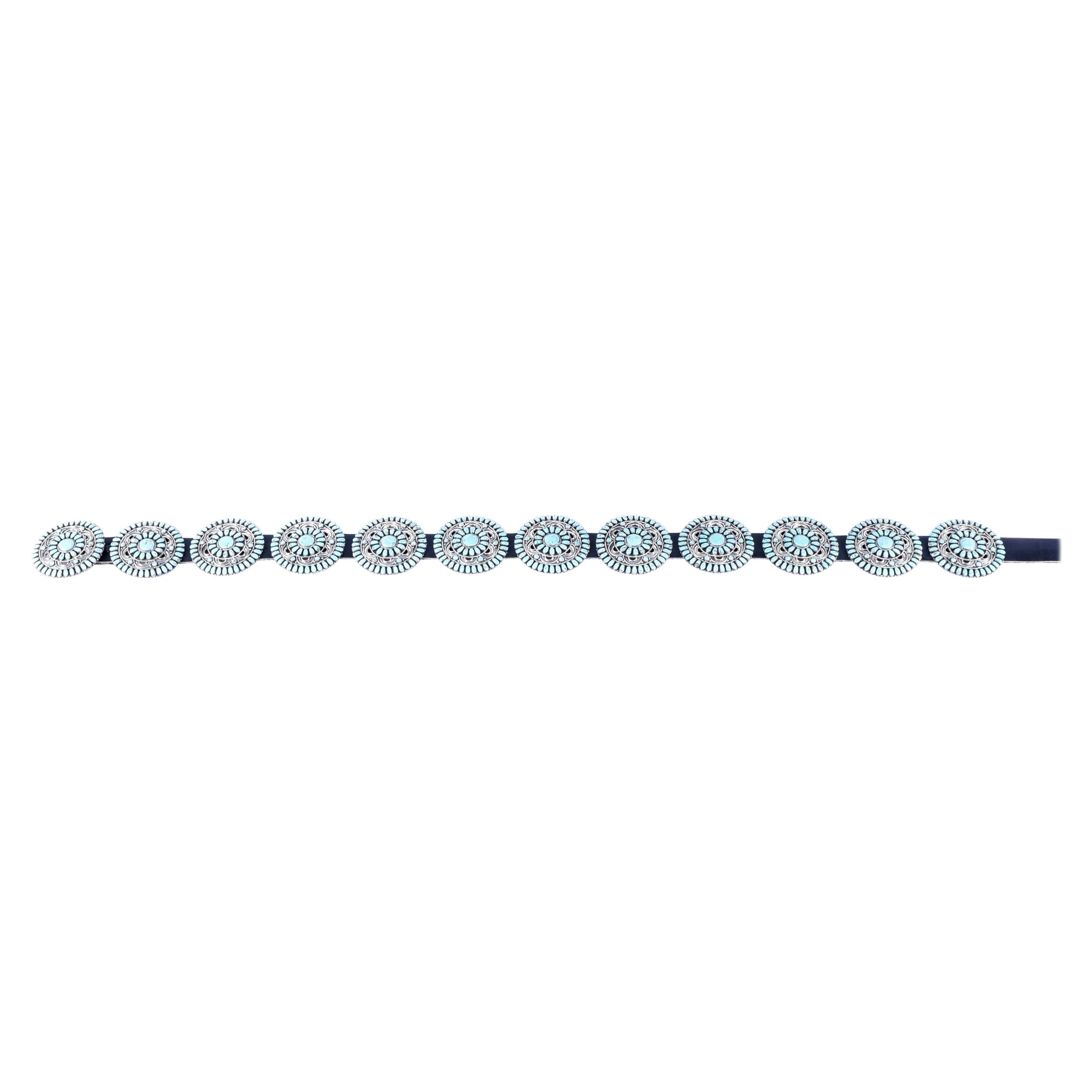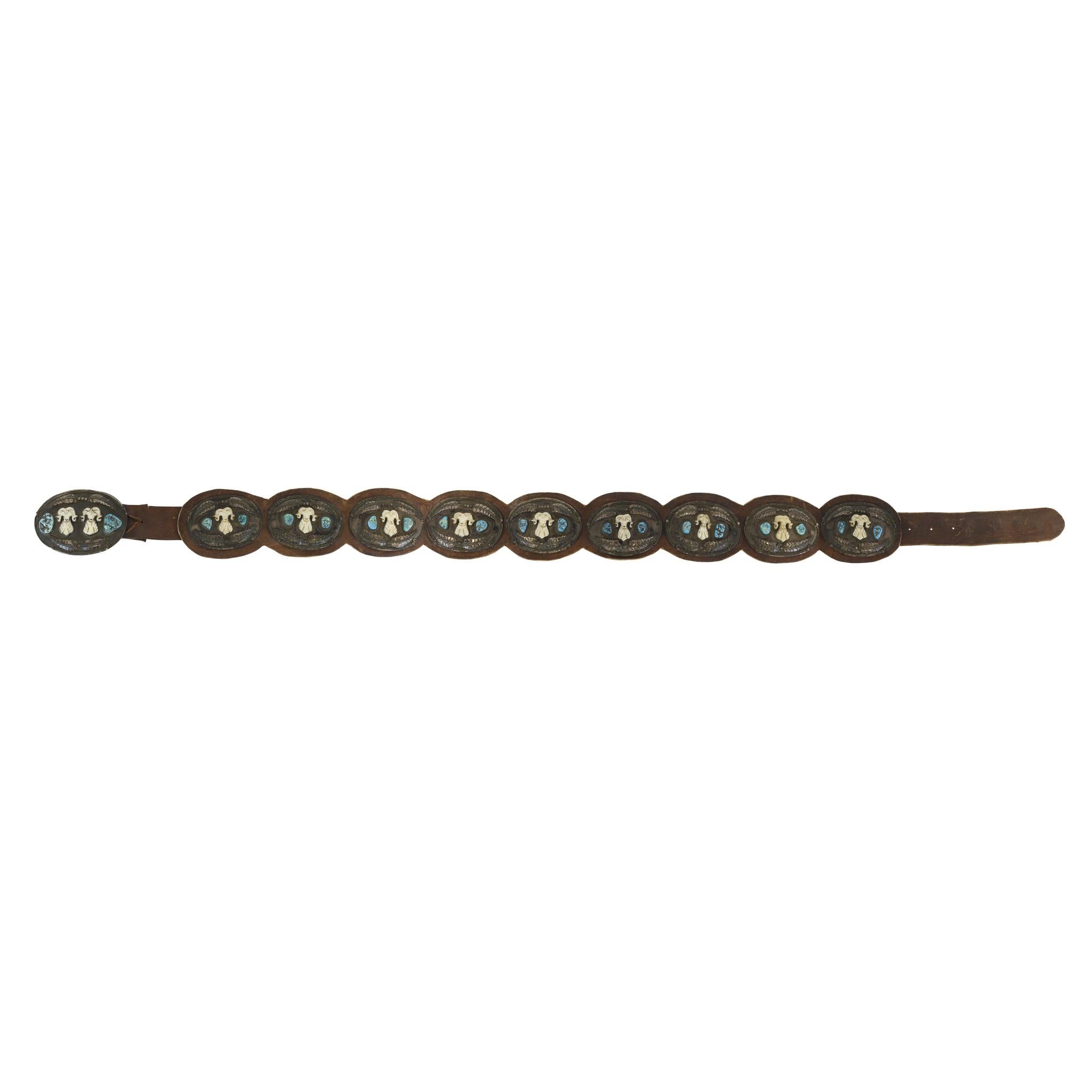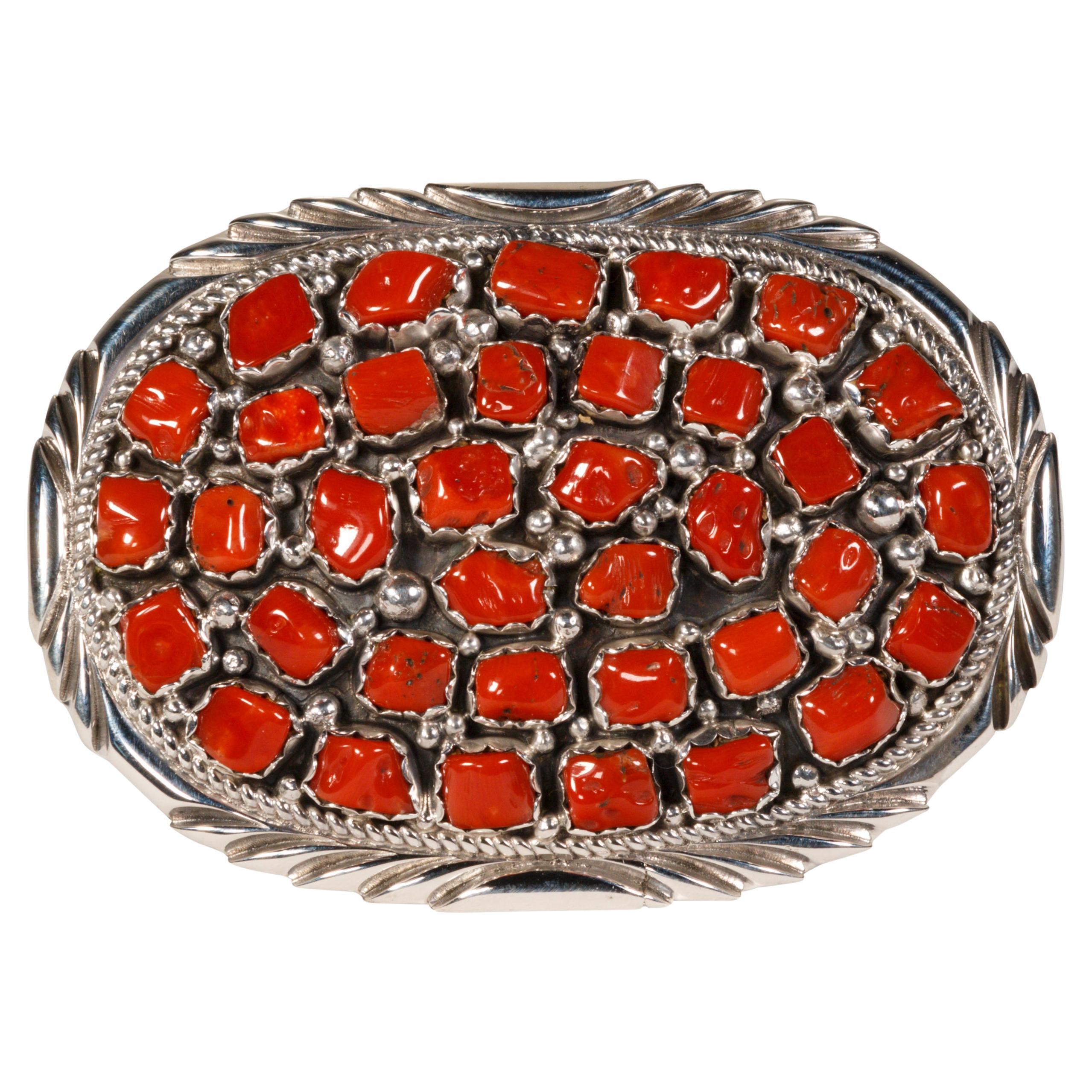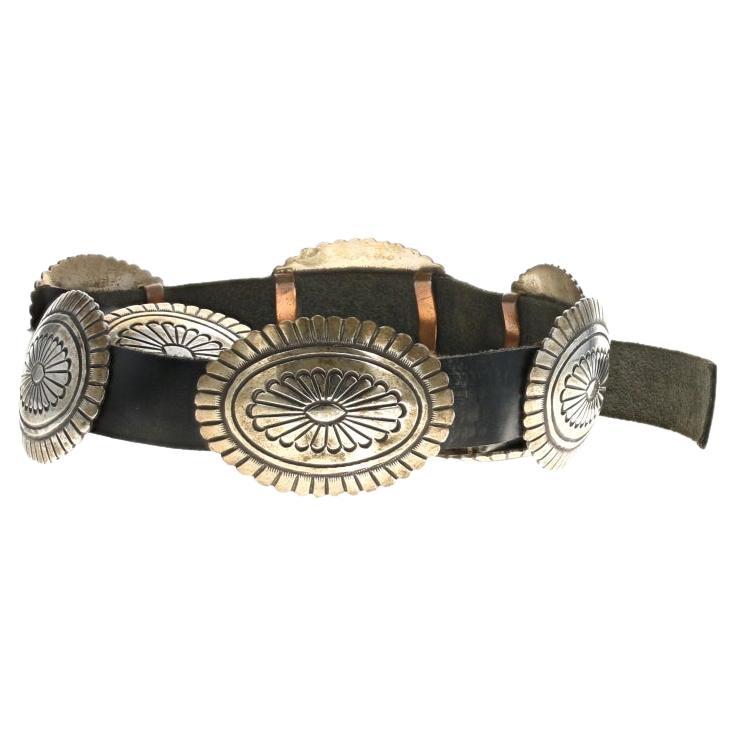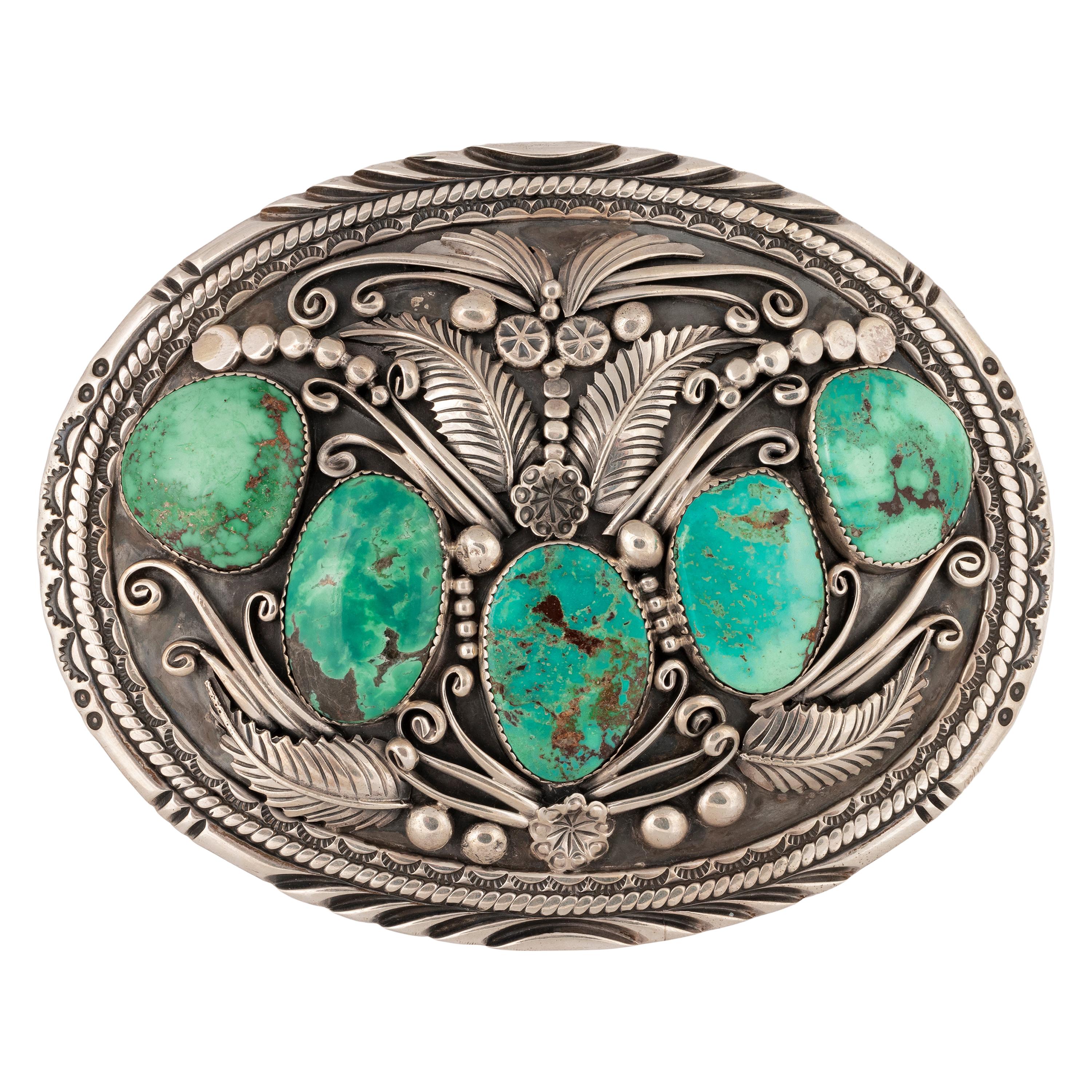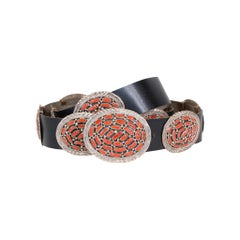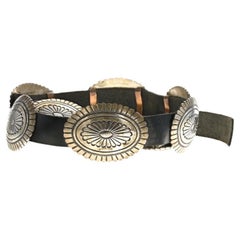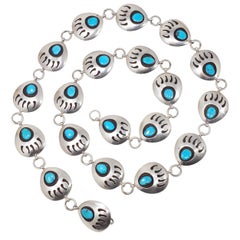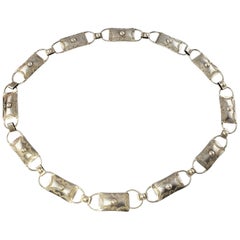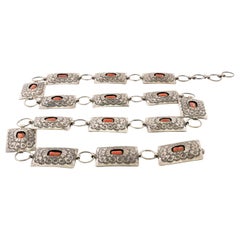
Navajo Sterling and Coral Concho Belt
View Similar Items
Want more images or videos?
Request additional images or videos from the seller
1 of 5
Navajo Sterling and Coral Concho Belt
About the Item
- Creator:
- Metal:
- Stone:
- Stone Cut:
- Dimensions:Width: 2 in (50.8 mm)Length: 38.25 in (971.55 mm)
- Style:
- Place of Origin:
- Period:
- Date of Manufacture:1960
- Condition:Wear consistent with age and use.
- Seller Location:Coeur d Alene, ID
- Reference Number:Seller: R3771stDibs: LU1357111017332
About the Seller
5.0
Gold Seller
These expertly vetted sellers are highly rated and consistently exceed customer expectations.
1stDibs seller since 2018
129 sales on 1stDibs
Typical response time: 13 hours
More From This SellerView All
- Navajo Coral Concho BeltBy NavajoLocated in Coeur d Alene, IDNavajo sterling concho belt with coral nuggets, beads and rope surround. 11 conchos 2 1/2" with larger buckle 3" x 2 1/2" on black leather belt. Trunk pie...Category
Vintage 1950s American Native American More Jewelry
MaterialsCoral, Sterling Silver
$7,000 - Navajo Turquoise Concho BeltBy NavajoLocated in Coeur d Alene, IDNavajo concho belt with rectangular turquoise slabs, surrounded by small stones. Signed RS. The turquoise is from the Kingman Mine in Arizona. Marked ster...Category
Vintage 1950s American Native American More Jewelry
MaterialsTurquoise, Sterling Silver
- Navajo Needlepoint Turquoise Concho BeltBy NavajoLocated in Coeur d Alene, IDSigned LMB. Marked sterling; 11 conchos total. PERIOD: After 1950 ORIGIN: Navajo, Southwest SIZE: Total Belt Length 62 1/2" Leather; conchos 2 1/4"D The word “concho” sometimes spelled “concha”, comes from the Spanish word meaning shell. Some of the first “conchos” were made of melted silver dollars and resembled a shell. Concho belts reportedly began appearing in Navajo country in the late 1860s. Other Native Americans including Zuni and Hopi also made traditional concho belts before long. Concho belts can cost into the thousands of dollars depending upon the craftsmanship, amount of silver, rarity of turquoise and stones used. Belts in the upper end of the price scales are usually made before the turn of the century. Buyers should deal with reputable dealers as many fakes and look-a-likes exist. A well-made belt with age to it will fetch a bigger premium and hold its value better. The earliest concho belts are now referred to as “First Phase” belts. This style of belt was made before Native silversmith had learned much about soldering. The conchos were hammered out from melted coins, cut, and filed into shape, engraved and a diamond shape slot was cut out of the middle of the concho, with a bar left across the center of the diamond shaped slot for the leather loop. Conchos that required no soldering are generally thought to be made from 1860-1880. Second phase conchos were done 1890-1900s in which silversmith began to solder. Third phase conchos is when you start to see the “butterfly” or “bow” appear between conchos and the use of turquoise as an adornment. A butterfly (bow) is a smaller concho in between bigger conchos. A belt with butterflies and sometimes turquoise would be from the early 1900s – 1930s. The timelines may slightly differentiate depending upon who you ask. Natives first had concho belts for personal use only, but around the turn of the last century, tourist demand had kicked in and a new outlet emerged. belts & buckles jewelry silver belts conchos navajo needlepoint southwest turquoise...Category
Vintage 1950s American Native American More Jewelry
MaterialsTurquoise, Sterling Silver
- Navajo Walrus Ivory and Turquoise Concho BeltBy NavajoLocated in Coeur d Alene, IDCarved ivory bighorns with Blue Kingman Mine turquoise. Wonderful patina. Original leather; nine conchos total. Signed A.J.M. PERIOD: After 1950 ORIGIN: Navajo, Southwest SIZE: Total belt length 56"; buckle 3 1/2" x 5"; conchos 3" x 4" The word “concho” sometimes spelled “concha”, comes from the Spanish word meaning shell. Some of the first “conchos” were made of melted silver dollars and resembled a shell. Concho belts reportedly began appearing in Navajo country in the late 1860s. Other Native Americans including Zuni and Hopi also made traditional concho belts before long. Concho belts can cost into the thousands of dollars depending upon the craftsmanship, amount of silver, rarity of turquoise and stones used. Belts in the upper end of the price scales are usually made before the turn of the century. Buyers should deal with reputable dealers as many fakes and look-a-likes exist. A well-made belt with age to it will fetch a bigger premium and hold its value better. The earliest concho belts are now referred to as “First Phase” belts. This style of belt was made before Native silversmith had learned much about soldering. The conchos were hammered out from melted coins, cut, and filed into shape, engraved and a diamond shape slot was cut out of the middle of the concho, with a bar left across the center of the diamond shaped slot for the leather loop. Conchos that required no soldering are generally thought to be made from 1860-1880. Second phase conchos were done 1890-1900s in which silversmith began to solder. Third phase conchos is when you start to see the “butterfly” or “bow” appear between conchos and the use of turquoise as an adornment. A butterfly (bow) is a smaller concho in between bigger conchos. A belt with butterflies...Category
Vintage 1950s American Native American More Jewelry
MaterialsTurquoise, Sterling Silver
- Navajo Coral Nugget Belt BuckleBy NavajoLocated in Coeur d Alene, IDShadowbox belt buckle with multi coral nuggets. Marked sterling silver. Made by Navajo silversmith J. Begay. Stunning oxblood coral stones surrounded by twisted rope border and sterl...Category
Late 20th Century American Native American More Jewelry
MaterialsCoral, Sterling Silver
- Navajo Turquoise, Coral and Bear Claw Belt BuckleBy NavajoLocated in Coeur d Alene, IDNavbajo Kingman turquoise and bear claw bracelet with small nugget of red coral. Stones and claw set in sterling silver surrounded by leaves, scrolls and bea...Category
Vintage 1980s American Native American More Jewelry
MaterialsTurquoise, Coral, Sterling Silver
You May Also Like
- Calvin Maloney Navajo Concho Belt, Sterling Silver Native AmericanLocated in Greensboro, NCThis Navajo belt would make a wonderful addition to a collection of First Nations art. Crafted by Calvin Maloney in sterling silver, the belt feature...Category
Late 20th Century Unknown More Jewelry
MaterialsSterling Silver
- Native American Bear Claw Link Sterling Silver Turquoise Concho BeltLocated in Milford, DEA vintage Native American bear claw link concho belt. Each link features a raised bear claw motif, accented with a turquoise cabochon, set in a sa...Category
Mid-20th Century American Native American More Jewelry
MaterialsTurquoise, Sterling Silver
$1,680 Sale Price20% OffFree Shipping - Native American Rectangle Concho BeltLocated in Washington Depot, CTVintage Native American Silver Rectangle Concho Belt- This lovely Native American Concho belt is crafted in beautifully detailed silver. Size: 30.5 inch...Category
20th Century Unknown Native American More Jewelry
MaterialsSilver
- Wide Ruins Gang, Concho Belt, designed by Melanie Yazzie, sterling silver, dogBy Melanie YazzieLocated in Santa Fe, NMWide Ruins Gang Concho Belt designed by Melanie Yazzie, cast sterling silver dogs, ram and sheep and leather strap. The strap is not punched. Customers' mea...Category
2010s American Artist More Jewelry
MaterialsSterling Silver
- Sterling Silver Belt Buckle Pawn Zuni LBJ Navajo Spiderweb TurquoiseLocated in Wallkill, NYLarge Hand set Turquoise stones surrounding a intricate Zuni Warrior set in sterling silver. Measures 3.00 inches w x 2.50in. Hallmarked LBJ on the back side of the buckle. Coral, Tu...Category
Vintage 1960s American Native American More Jewelry
MaterialsCoral, Turquoise, Sterling Silver
- Archaeological-Revival Coral and Gold Spartan DiademLocated in London, GBAn archaeological-revival coral and gold Spartan diadem, in the form of a gold band with seven concave discs each set with a cabochon coral, alternating with eight floral motifs each set with a small cabochon coral, all with gold wirework decorations of Etruscan style, made in Naples circa 1840, bearing gold hallmarks N3 with the profile of Parthenope, gross weight 94 grams. A gorgeous and sumptuous Spartan diadem, made in the mid-nineteenth century in Italy. Beginning in the early nineteenth century, jewellery inspired by the Ancient World became very popular. This diadem is made from bright yellow gold in which is set seven glowing orange cabochon-cut coral stones within carved gold discs. Further gold wirework and smaller coral stones add to the beauty of this piece, which is simple and bold. By family repute, this diadem, purchased in England during the early part of the 20th century, was once owned by Empress Eugénie of France. Winterhalter's portrait of the Empress in 1864 depicts her wearing a gold diadem similar in design to this one. Eugénie loved jewels and as well as enjoying the sumptuous French crown jewels...Category
Antique 1840s Italian Classical Roman More Jewelry
MaterialsCoral, 18k Gold, Yellow Gold
Recently Viewed
View AllMore Ways To Browse
Navajo Silver Belt
Vintage Conchos
Vintage Concho
Sterling Concho
Concho Sterling
Native American Concho
Concho Belt Used
Concho Belt
Navajo Concho
Vintage Sterling Conchos
Vintage Sterling Silver Conchos
Silver Concho Belt
Vintage Concho Belt
Silver Concho Belt Vintage
Native American Concho Belt
Native American Concho Belts
Sterling Concho Belt
Sterling Silver Concho Belt


